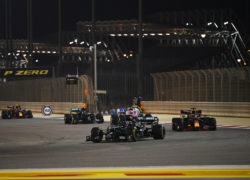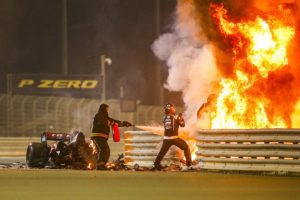
A cursory glance at the results of the weekend’s F1 race would reveal another seemingly comfortable victory for Lewis Hamilton ahead of Max Verstappen and Alex Albon. But it would not even begin to tell the story of the 2020 Bahrain grand prix.
The race was immediately brought to stop after only three corners. From the wide shot it appeared that a car had made impact with the outside barrier on turn three and burst into flames. It was a sight highly uncommon in Formula 1. It was soon confirmed that the driver involved was Romain Grosjean. Due to the seriousness of the crash and a lack of immediate information on the driver’s conditions no replays were shown of the incident. Several moments later however the broadcast cameras picked up Grosjean being assisted away from the scene by Dr. Ian Roberts and medical car driver Alan van der Merwe.
With Grosjean seemingly without serious injury the replays were broadcast. The horrific images revealed that the Haas had split into upon impact and that the front section had pierced the steel barrier. The medical car, which always follows the field at the start of a race, stopped at the scene moments later. Ian Roberts ran towards the raging flames as marshals and Alan van der Merwe attempted to douse the fire with extinguishers. Dr. Roberts later reported that the fire extinguisher pushed the flames back just enough for him to assist Grosjean over what was left of the barrier. As it were Grosjean was in the burning car for roughly twenty seconds before being able to pull himself out. He suffered second-degree burns on his hands and some burns to his left foot. Dr. Roberts also reported that the visor on Grosjean’s was melted. It is believed that the impact of the car with the barrier was registered at 221km/h and 53G.
From the monocoque, to the safety belts, to the fireproof overalls everything worked in unison in the crash to allow Grosjean to walk away with only minor injuries. And there was one other piece of equipment that ensured his survival, the Halo. The burnt monocoque was unrecognizable but clearly showed the halo head protection system completely intact. From early assessments, by Ross Brawn and others, it is clear that the Halo had played a significant role in saving Romain Grosjean’s life. There should never again be a discussion about the Halo’s inclusion in the sport and any and all detractors would be best served by keeping their asinine opinions to themselves.
 The red flag lasted from more than an hour as track workers replaced the destroyed barrier. The race barely got underway before the safety car was called upon. This time it was Lance Stroll who found himself upside down in the Racing Point after a coming together with Dannil Kvyat. Thankfully, Stroll was uninjured. Racing resumed with Hamilton in the lead and Verstappen in second.
The red flag lasted from more than an hour as track workers replaced the destroyed barrier. The race barely got underway before the safety car was called upon. This time it was Lance Stroll who found himself upside down in the Racing Point after a coming together with Dannil Kvyat. Thankfully, Stroll was uninjured. Racing resumed with Hamilton in the lead and Verstappen in second.
The Merc driver was able to maintain a gap of around four seconds to the Red Bull for most of the race. Verstappen made a late pitstop for fresh tyres and an attempt at the fastest lap. Sergio Perez had been running solidly in third for the majority of the race but was forced into retirement with only three laps to go. As it were Albon inherited third place.
McLaren completed a good day at the office with Lando Norris in fourth and Carlos Sainz in fifth. The Alpha Tauri of Pierre Gasly was sixth ahead of Ricciardo in seventh. Bottas, who had suffered an early puncture, was eighth while Ocon and Leclerc was ninth and tenth.
As fans of the sport we always hope for a spectacle, an edge-of-the-seat race that gets the heart pumping. But on this occasion the anti-climax at the end of it was welcomed. Absolute safety in F1 can never be guaranteed. But because of the work that has been done by the likes of Sir Jackie Stewart, Prof. Sid Watkins, Alex Wurz, and so many others Romain Grosjean was able to walk away from a horrifying crash. We owe all of them the greatest debt of gratitude.


